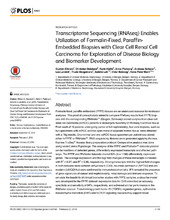| dc.description.abstract | Formalin-fixed, paraffin-embedded (FFPE) tissues are an underused resource for molecular analyses. This proof of concept study aimed to compare RNAseq results from FFPE biopsies with the corresponding RNAlater® (Qiagen, Germany) stored samples from clear cell renal cell carcinoma (ccRCC) patients to investigate feasibility of RNAseq in archival tissue. From each of 16 patients undergoing partial or full nephrectomy, four core biopsies, such as two specimens with ccRCC and two specimens of adjacent normal tissue, were obtained with a 16g needle. One normal and one ccRCC tissue specimen per patient was stored either in FFPE or RNAlater®. RNA sequencing libraries were generated applying the new Illumina TruSeq® Access library preparation protocol. Comparative analysis was done using voom/Limma R-package. The analysis of the FFPE and RNAlater® datasets yielded similar numbers of detected genes, differentially expressed transcripts and affected pathways. The FFPE and RNAlater datasets shared 80% (n = 1106) differentially expressed genes. The average expression and the log2 fold changes of these transcripts correlated with R2 = 0.97, and R2 = 0.96, respectively. Among transcripts with the highest fold changes in both datasets were carbonic anhydrase 9 (CA9), neuronal pentraxin-2 (NPTX2) and uromodulin (UMOD) that were confirmed by immunohistochemistry. IPA revealed the presence of gene signatures of cancer and nephrotoxicity, renal damage and immune response. To simulate the feasibility of clinical biomarker studies with FFPE samples, a classifier model was developed for the FFPE dataset: expression data for CA9 alone had an accuracy, specificity and sensitivity of 94%, respectively, and achieved similar performance in the RNAlater dataset. Transforming growth factor-ß1 (TGFB1)-regulated genes, epithelial to mesenchymal transition (EMT) and NOTCH signaling cascade may support novel therapeutic strategies. In conclusion, in this proof of concept study, RNAseq data obtained from FFPE kidney biopsies are comparable to data obtained from fresh stored material, thereby expanding the utility of archival tissue specimens. | en_US |

